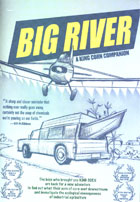
Big River: A King Corn Companion 2009
Distributed by Bullfrog Films, PO Box 149, Oley, PA 19547; 800-543-FROG (3764)
Produced by Ian Cheney, Wicked Delicate Films and the Independent Television Service (ITVS)
Directed by Curt Ellis
DVD, color, 27 min.
Jr. High - Adult
Agriculture, American Studies, Economics, Environmental Studies, Food, Water
Date Entered: 03/12/2010
Reviewed by Janis Tyhurst, Reference Librarian, George Fox UniversityBig River is a short follow up documentary to King Corn, taking place just a few years after King Corn was filmed. When the floods of 2008 hit the Midwest, Greene, IA was among one of the hardest hit towns. This started Ian Cheney and Curt Ellis thinking about their corn farming experience as they canoed through the flooded town of Greene, wondering if something besides the corn harvest left the farm.
There are 7 chapters (Opening; Pesticides; Topsoil; Fertilizer Factory; Water Works; Hypoxia; Heartland). The DVD includes a shortened version (50 minutes) of King Corn as well. The story flows along well, using the same storytelling style seen in King Corn, with a voiceover narration leading us through visual graphics, statistics, and trips to the local rivers, Terra Industry (the fertilizer factory), the Des Moines Water Works, and on down to Cocodrie, LA.
Meeting up with Chuck Pyatt, their former landlord from King Corn, they start looking into the water around Greene, IA and the water that flows on down from Greene to the Gulf Coast. The chapters on Pesticides and Topsoils address the problems faced by farmers in producing crops, the fixes used to solve these problems and the resulting problems created by the fixes. The next two chapters, Fertilizer Factory and Water Works, show the industries that have grown because of the fixes used by farmers and their costs to society. The last two chapters, Hypoxia and Heartland, present the connection between farming, fishing and long term health.
In each chapter, specialists, professionals and academics are interviewed to provide in- depth explanations. In between the interviews, examples and graphs of the effects and consequences are given. There are some startling statistics such as an estimated 33 million people in the U.S., especially those living in the Midwest, have been exposed to the pesticide Atrazine; or that farmers use approximately 130 pounds of anhydrous ammonia to fertilize one acre of farmland and that it takes 2000 cubic feet of natural gas to produce one pound of anhydrous ammonia; or that, since 1992, Des Moines has the largest nitrate removal facility in the world. Cheney & Ellis also connect the dots between the proliferations of dead zones in the ocean with the use of fertilizers upstream and posit the theory that the chemicals being used by farmers are carcinogenic.
Big River provides a concise overview of the environmental and economic factors at work in American agriculture and a compelling look at the long term consequences of maintaining the status quo. King Corn and Big River complement each other, with King Corn providing the historical and political context for current agricultural practices and Big River showing the personal and societal costs of these agricultural practices.